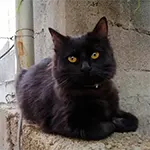Origin and History
The Cymric (pronounced “KIM-rik”) is a breed of domestic cat noted for its lack of a tail, which is the result of a genetic mutation. It is essentially the long-haired variant of the Manx cat and shares the same origin story, hailing from the Isle of Man. The breed’s history on the island goes back centuries, where it naturally occurred due to the genetic mutation for taillessness being passed down through generations of island cats. The name “Cymric” was later adopted, derived from “Cymru,” the Welsh name for Wales, although the breed has no historical ties to Wales. The Cymric was developed as a distinct breed through selective breeding programs that began in the 1960s and 1970s, emphasizing its unique taillessness and long, plush coat.
Appearance
Cymric cats are medium to large in size, with a rounded appearance that is enhanced by their dense, long double coat. They are best known for their varying tail lengths – from rumpy (no tail) to rumpy-riser (a bump of cartilage or a few tail vertebrae under the fur), stumpy (a short stub of a tail), and longy (a tail almost normal in length). Their body is solid and muscular, with a round head, prominent cheeks, broad chest, and short back, giving them a distinctive, rounded silhouette.
The coat of the Cymric is one of its most striking features, being thick, soft, and long all over the body, with a noticeable plushness around the neck, creating a mane-like effect. They come in a wide variety of colors and patterns, including solid colors, tabby patterns, tortoiseshell, and calico.
Their eyes are large and round, set wide apart, and can be any color, often reflecting the coat color. The ears are medium-sized, wide at the base, and taper to a rounded tip, set well apart and contributing to their expressive facial appearance.
Personality and Temperament
Cymric cats are known for their gentle, playful, and affectionate nature. They are sociable creatures that form strong bonds with their human families, often following them around the house and participating in their activities. Cymrics are intelligent and curious, enjoying interactive toys and puzzles that challenge them mentally. They are also known for their excellent hunting abilities, a trait they share with their Manx counterparts.
These cats are great companions, adaptable to various living situations, and tend to get along well with children and other pets. Despite their playful side, they also appreciate quiet time and enjoy cuddling with their owners. Their gentle and patient demeanor makes them a good choice for families and individuals alike.
Health
Cymric cats are generally healthy, but the gene that causes their taillessness can also lead to spinal and skeletal issues, such as spina bifida, where the spine does not develop properly. This condition can lead to a range of health problems, from incontinence to mobility issues, although not all tailless cats will experience these problems.
Like all cats, Cymrics benefit from regular veterinary check-ups and a healthy lifestyle. They have a dense coat that requires regular grooming to prevent matting and to keep their skin healthy.
In summary, the Cymric cat is a distinctive, tailless breed known for its plush coat, rounded appearance, and affectionate personality. They make loyal and loving companions, suited to a variety of homes where they can receive the attention and care they thrive on.










